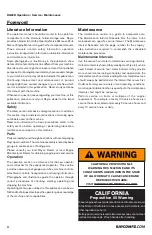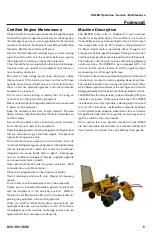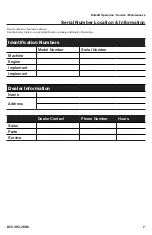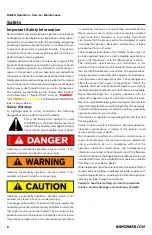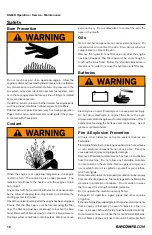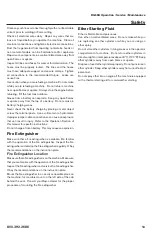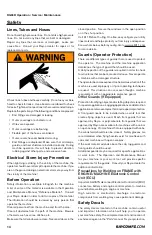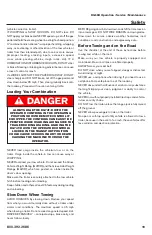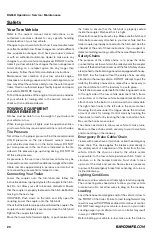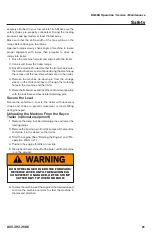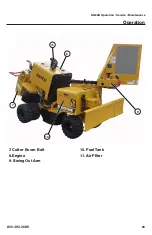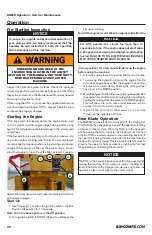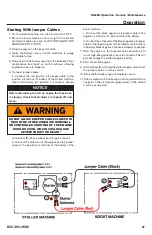
RG55R Operation • Service • Maintenance
800.392.2686
17
Safety
features of the equipment in operation and the effects
on machine stability.
• Operating techniques – Keep all attachments or pulled
loads low to the ground for optimum stability.
• Machine systems have limitations on slopes – Slopes can
affect the proper function and operation of the various
machine systems. These machine systems are needed
for machine control on slopes.
• Note: Safe operation on steep slopes may require special
machine maintenance. Excellent skill of the operator
and proper equipment for specific applications are
also required. Consult the Operation and Maintenance
Manual sections for the proper fluid level requirements
and intended machine use.
Work Tool options - Attachments
Only use work tools that are approved by Rayco for use on
Rayco machines. Refer to the Operation and Maintenance
Manual, Rayco options.
If you are in doubt about the compatibility of a particular work
tool with your machine, consult your Rayco dealer.
Make sure that all necessary guarding is in place on the host
machine and on the work tool.
Always wear protective glasses. Always wear the protective
equipment that is recommended in the work tool’s operation
manual. Wear any other protective equipment that is required
for the operating environment.
To prevent personnel from being struck by flying objects,
ensure that all personnel are out of the work area.
While you are performing any maintenance, any testing, or
any adjustments to the machine, stay clear of the following
areas: cutting edges, pinching surfaces, and crushing
surfaces.
Equipment Lowering with Engine
Stopped
Before lowering any equipment with the engine stopped,
clear the area around the equipment of all personnel. The
procedure to use will vary with the type of equipment to be
lowered. Keep in mind this system use a high pressure fluid
to raise or lower equipment. The procedure will cause high
pressure hydraulic oil to be released in order to lower the
equipment. Wear appropriate personal protective equipment
and follow the established procedure in the Operation and
Maintenance Manual.
LOCK-Out / Tag-Out Guidelines
Always practice lock out tag out procedures when working
on this machine.
Locking and tagging out equipment safeguards those working
on the equipment from being injured by its unexpected
energy or releasing stored energy. This section summarizes
the applicable requirements for lockout/ tag out procedures,
and its intent to comply with OSHA regulations.
Lock Out Procedure
• All affected persons are to be notified that the equipment
will be off and locked out.
• All energy sources for the equipment should be identified.
• The equipment shall be shut off or otherwise de-
energized, being careful to de-energize all energy
sources. This includes all valves, switches, breakers, or
other controls that supplies energy to the equipment.
In case of mechanical energy, a block may be used to
stop the release of stored energy.
• A lock is to be placed on each energy source disconnect
or energy release block.
1. The lock is to be placed directly on the equipment if
provided with an integral locking device.
2. If there is no integral lockout device on the equipment,
securely attach an independently manufactured lockout
device on the equipment and then place the lock on the
lockout device.
3. If none of the above are possible, use the tag out
procedure.
• A tag to be secured to the lock indicating that the
equipment is not to be energized and who owns the lock.
• It should be safely tested and verified that the lockout
does prevent the release of energy.
Tag Out Procedure
• This procedure is to be used only if it is not reasonable
to use the lockout procedure.
• All affected persons are to be notified that the equipment
will be shut off and tagged out.
• All energy sources for the equipment should be identified.
• The equipment shall be shut off or otherwise de-
energized, being careful to de-energize all energy
sources. This includes all valves, switches, breakers, or
other controls that supplies energy to the equipment.
in case of mechanical energy, a block may be used to
stop the release of stored energy.
• Securely place a tag on each energy source disconnect
or energy release block.
Before the removal of a lockout/tag out
the following must be completed:
1. Removal of all non essential items.
2. Check to see that all workers and bystanders are
located in a safe position.
3. Inform all affected personnel.
• If a worker who applied the lockout/tag out is not present,
and his supervisor deems it necessary to energize the
equipment, the following must be done by the supervisor.
1. Make all reasonable effort to contact the worker who
placed the tag.
2. Determine the purpose of the lockout/tag out, and
whether it is safe to operate the equipment in its current
Summary of Contents for RG55
Page 27: ...RG55R Operation Service Maintenance 800 392 2686 27 Operation ...
Page 58: ...RG55R Operation Service Maintenance 58 Hydraulic Schematic 805921 ...
Page 59: ...RG55R Operation Service Maintenance 800 392 2686 59 Hydraulic Schematic 805921 ...
Page 67: ...RG55R Operation Service Maintenance 800 392 2686 67 Specifications ...


